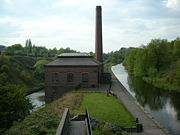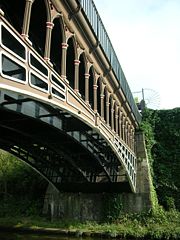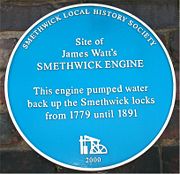
Smethwick Engine
Encyclopedia



Watt steam engine
The Watt steam engine was the first type of steam engine to make use of steam at a pressure just above atmospheric to drive the piston helped by a partial vacuum...
made by Boulton and Watt
Boulton and Watt
The firm of Boulton & Watt was initially a partnership between Matthew Boulton and James Watt.-The engine partnership:The partnership was formed in 1775 to exploit Watt's patent for a steam engine with a separate condenser. This made much more efficient use of its fuel than the older Newcomen engine...
; brought into service in May 1779.
Originally, it was one of two engines used to pump water back up to the 491 feet (149.7 m) summit level of the BCN Old Main Line (Birmingham Canal)
BCN Main Line
The BCN Main Line, or Birmingham Canal Navigations Main Line describes the evolving route of the Birmingham Canal between Birmingham and Wolverhampton in England....
canal
Canal
Canals are man-made channels for water. There are two types of canal:#Waterways: navigable transportation canals used for carrying ships and boats shipping goods and conveying people, further subdivided into two kinds:...
at Smethwick
Smethwick
Smethwick is a town in the Metropolitan Borough of Sandwell, in the West Midlands of England. It is situated on the edge of the city of Birmingham, within the historic boundaries of Staffordshire, Worcestershire and Warwickshire....
, not far from the Soho Foundry
Soho Foundry
Soho Foundry was a factory created in 1795 by Matthew Boulton and James Watt at Smethwick, West Midlands, England , for the manufacture of steam engines.-History:...
where it was made. The other engine, also built by Boulton and Watt
Boulton and Watt
The firm of Boulton & Watt was initially a partnership between Matthew Boulton and James Watt.-The engine partnership:The partnership was formed in 1775 to exploit Watt's patent for a steam engine with a separate condenser. This made much more efficient use of its fuel than the older Newcomen engine...
, was at the other end of the summit level at Spon Lane. In 1804 a second Boulton and Watt engine was added alongside the 1779 engine.
The engines were needed because local water sources were insufficient to supply water to operate the six locks either side of the canal's original summit. The locks could have been avoided if a tunnel had been built, but the ground was too unstable for James Brindley
James Brindley
James Brindley was an English engineer. He was born in Tunstead, Derbyshire, and lived much of his life in Leek, Staffordshire, becoming one of the most notable engineers of the 18th century.-Early life:...
to build a tunnel using the techniques available at the time. In the 1780s, a cutting was constructed by John Smeaton
John Smeaton
John Smeaton, FRS, was an English civil engineer responsible for the design of bridges, canals, harbours and lighthouses. He was also a capable mechanical engineer and an eminent physicist...
, enabling three of the six locks on each side to be removed.
In the 1820s, Thomas Telford
Thomas Telford
Thomas Telford FRS, FRSE was a Scottish civil engineer, architect and stonemason, and a noted road, bridge and canal builder.-Early career:...
constructed a new canal parallel to the old in a deeper cutting, at the 453 ft Birmingham Level, creating the largest man-made earthworks in the world at the time. It was spanned by the Galton Bridge
Galton Bridge
Galton Bridge is a canal bridge in Smethwick, West Midlands, England built by Thomas Telford in 1829. It spans Telford's Birmingham Canal Navigations New Main Line carrying Roebuck Lane. When it was constructed, its single span of 151 feet was the highest in the world . Originally a road bridge...
. The engine was still needed, despite both these developments, and Thomas Telford
Thomas Telford
Thomas Telford FRS, FRSE was a Scottish civil engineer, architect and stonemason, and a noted road, bridge and canal builder.-Early career:...
constructed the Engine Arm Aqueduct carrying the Engine Arm
Engine Arm
The Engine Arm or Birmingham Feeder Arm near Smethwick, West Midlands, England, is a short canal built by Thomas Telford in 1825 to carry water from Rotton Park Reservoir to the Old Main Line of the BCN Main Line Canal....
branch canal over his New Main Line so that coal could still be transported along the arm to feed the Smethwick Engine.
In 1892, a replacement engine was built in a new pumping house, now Grade II listed, next to Brasshouse Lane, as the original Smethwick Engine was considered uneconomic to repair. This new pumping house is now part of the nearby Galton Valley Canal Heritage Centre
Galton Valley Canal Heritage Centre
Galton Valley Canal Heritage Centre is a small museum, located in Smethwick, on the border with Birmingham and alongside the BCN Main Line canal, which focuses on civil engineering feats in the local area...
. The original Smethwick Engine was then removed to British Waterways
British Waterways
British Waterways is a statutory corporation wholly owned by the government of the United Kingdom, serving as the navigation authority in England, Scotland and Wales for the vast majority of the canals as well as a number of rivers and docks...
Ocker Hill depot where it remained until acquired by Birmingham City Council
Birmingham City Council
The Birmingham City Council is the body responsible for the governance of the City of Birmingham in England, which has been a metropolitan district since 1974. It is the most populated local authority in the United Kingdom with, following a reorganisation of boundaries in June 2004, 120 Birmingham...
. It is now at the Thinktank science museum at Millennium Point in Birmingham
Birmingham
Birmingham is a city and metropolitan borough in the West Midlands of England. It is the most populous British city outside the capital London, with a population of 1,036,900 , and lies at the heart of the West Midlands conurbation, the second most populous urban area in the United Kingdom with a...
and is the oldest working engine in the world.
The engine house was demolished in 1897. Its original site and foundations can still be seen on Bridge Street North in Smethwick, just north of the junction with Rolfe Street.
Points of interest
See also
- Canals of the United KingdomCanals of the United KingdomThe canals of the United Kingdom are a major part of the network of inland waterways in the United Kingdom. They have a colourful history, from use for irrigation and transport, through becoming the focus of the Industrial Revolution, to today's role for recreational boating...
- History of the British canal systemHistory of the British canal systemThe British canal system of water transport played a vital role in the United Kingdom's Industrial Revolution at a time when roads were only just emerging from the medieval mud and long trains of pack horses were the only means of "mass" transit by road of raw materials and finished products The...

